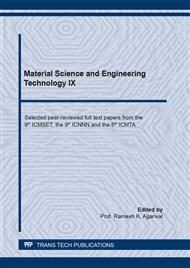
The study of composites made from residual organic materials and polymeric resins, has a great projection due to the use of new raw materials and the good physical, mechanical and aesthetic characteristics these materials present in the construction industry. The manufacturing processes of these composites include the necessary pressure application to generate an efficiently compact material, where matrix and reinforcement bonding are efficient. This study defines how the compaction force influences the flexural strength of composites made from polyester resin as polymer matrix, and rice husk as reinforcement material. This is achieved by testing different series of specimens, made by applying different compaction forces in a cold process, to analyse the relationship between compaction and flexural strength. Specimens are made varying only the compaction force, from 2, 5, 8, 11, 14, and 17 tons. The results show that, when the compaction force increases, the flexural strength in the composites also increases, however, there is a pressure range where the flexural strength values are very close, conditioning the use of pressure in relation to the decrease in the specimen section.
You might also be interested in these eBooks
Info:
© 2021 Trans Tech Publications Ltd. All Rights Reserved
[1]
S. Dixit RGADPRSaTB. Natural fibre reinforced polymer composite materials-a review. Polymer from renewable saurces. 2017;(71-78).
Google Scholar
[2]
B. Marques ATJAJAaJdB. Mechanical, thermal and acoustic behaviour of polymer-based composite materials produced with rice husk and expanded cork by-products. Construction and Building Materials. (2020).
DOI: 10.1016/j.conbuildmat.2019.117851
Google Scholar
[3]
J. Antonio ATBMJASAaVP. Application of rice husk in the development of new composite boards. Construction and Building Materials. 2018;(432-439).
Google Scholar
[4]
E Chabi VDSPHaECA. Study of cement composites on addition of rice husk. Case studies in Construction Materials. 2020;(e00345).
DOI: 10.1016/j.cscm.2020.e00345
Google Scholar
[5]
D. Battegazzore JADDaAF. All Natural High-Density Fiber-and Particleboards From Hemp Fibers or Rice Husk Particles. Journal of Polymers and the Environment. 2018;(1652-1660).
DOI: 10.1007/s10924-017-1071-9
Google Scholar
[6]
S. A. N. Mohamed ESZSMSMDAaAMTA. Energy behaviour assesment of rice husk fibres reinforced polymer composite. Journal of Materials Research and Technology. 2020;(383-393).
Google Scholar
[7]
M. A. Kashfipour NMaJZ. A review on the role of interface in mechanical, thermal, and electrical properties of polymer composites. Advanced Composites and Hybrid Materials volume. 2018;(415-439).
DOI: 10.1007/s42114-018-0022-9
Google Scholar
[8]
F. Sandoval LHDHAFaRC. Evaluación de la actividad antibacteriana del extracto de Rhoeo Discolor (Barranquilla). Revista de Energía Física y Química. 2015 Enero-Marzo; 2(2).
Google Scholar
[9]
M. Salvado MMFJBaBMS. Proceso de fabricación de estructuras de materiales compuestos de fibra de carbono mediante moldeo por compresión asistido por membranas. Materiales Compuestos. 2017 Mayo; 2(3).
DOI: 10.25100/iyc.v18i2.2163
Google Scholar
[10]
M. Vanoli AdOJGTdPRFLM. Eucalyptus wood and coffee parchment for particleboard production: Physical and mechanical properties. Ciencia e Agrotecnologia. 2016 Abril; (139-146). x.
Google Scholar


